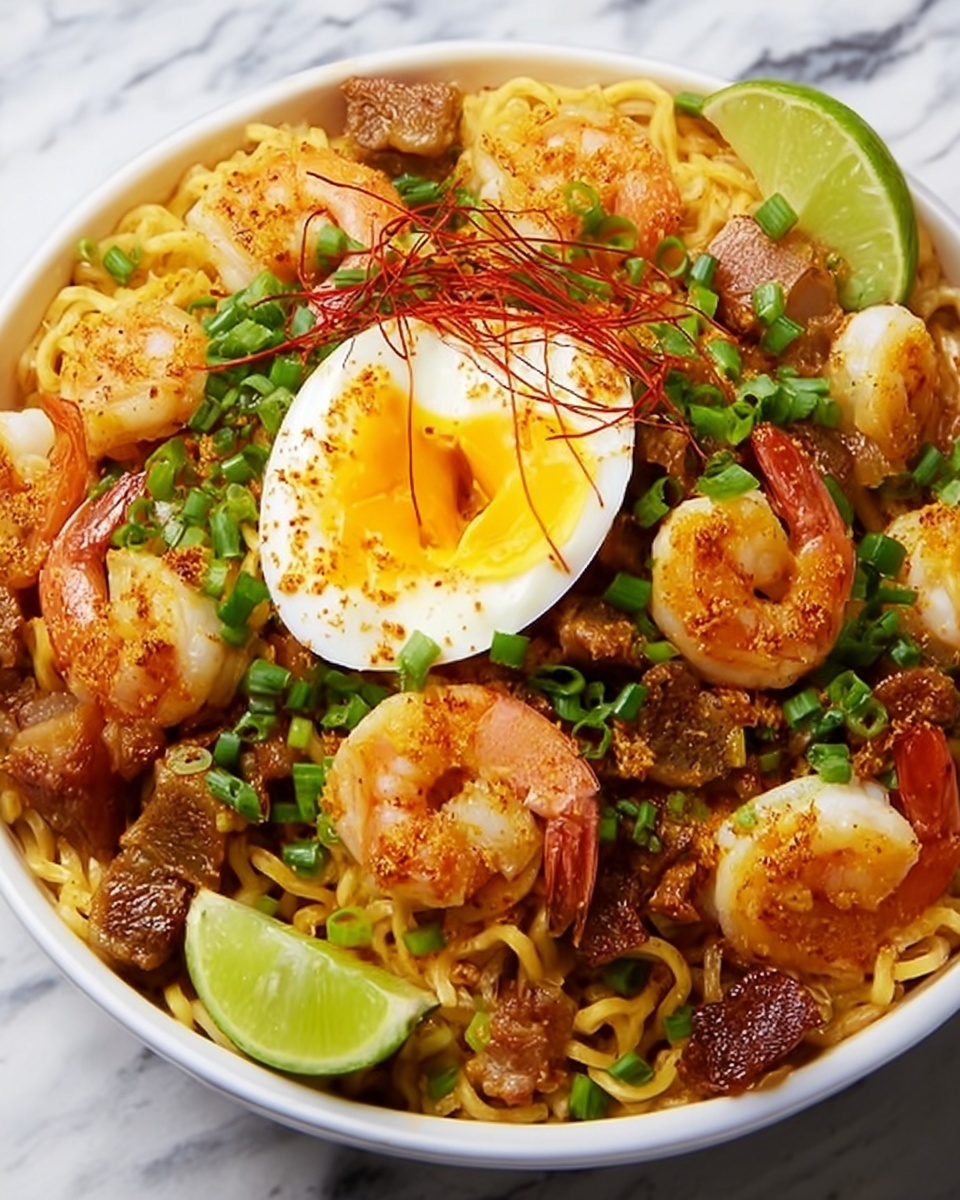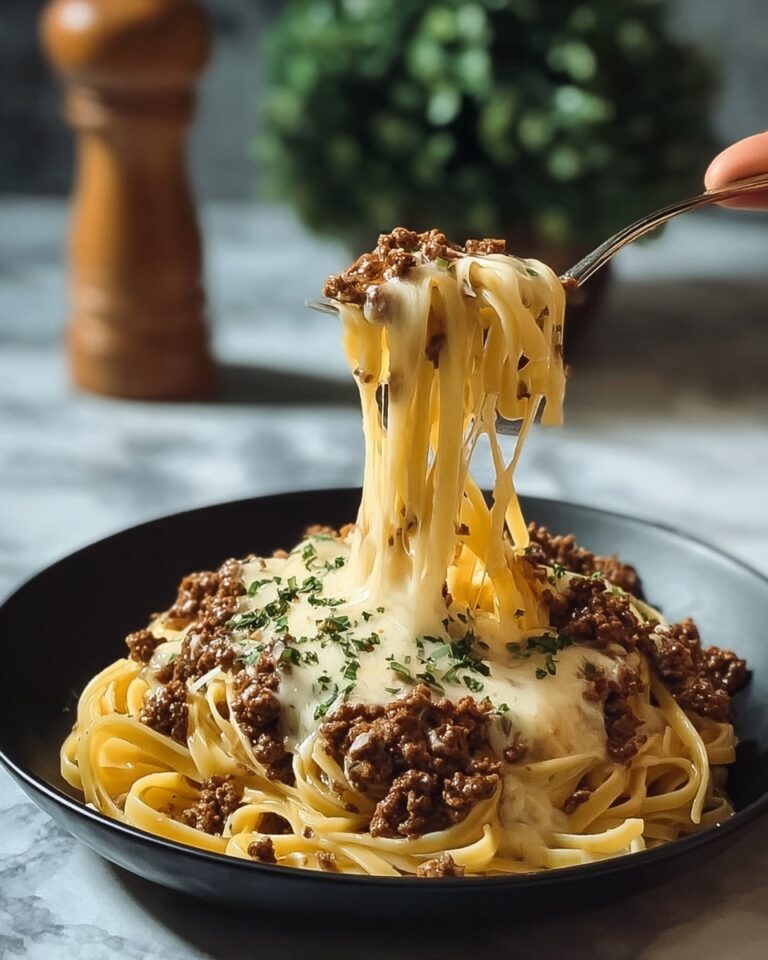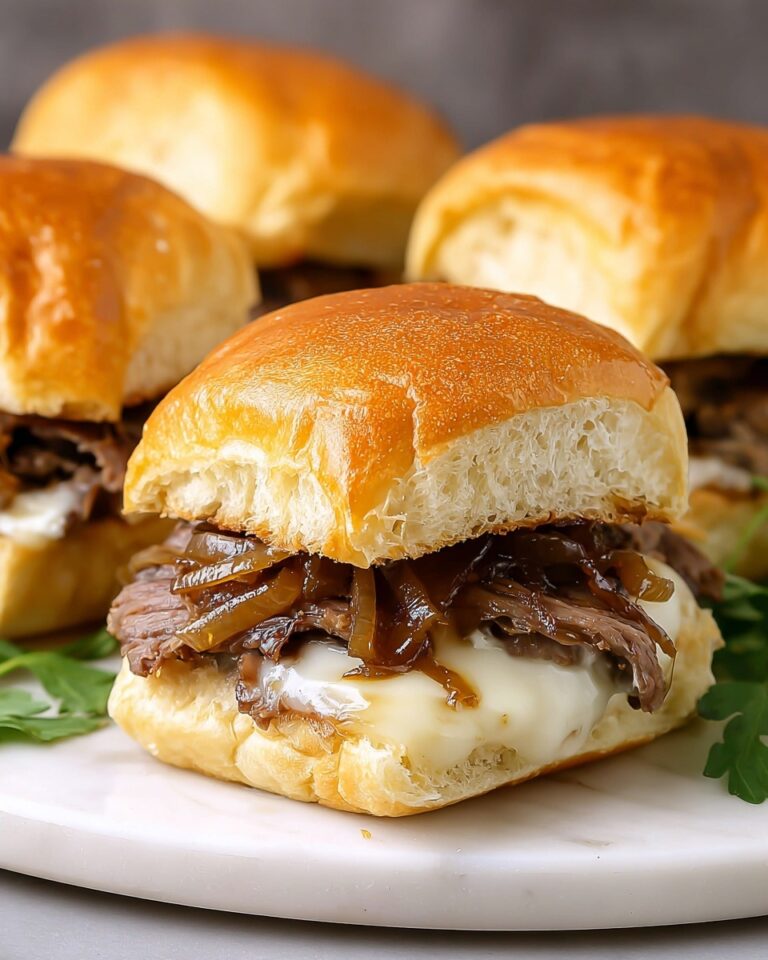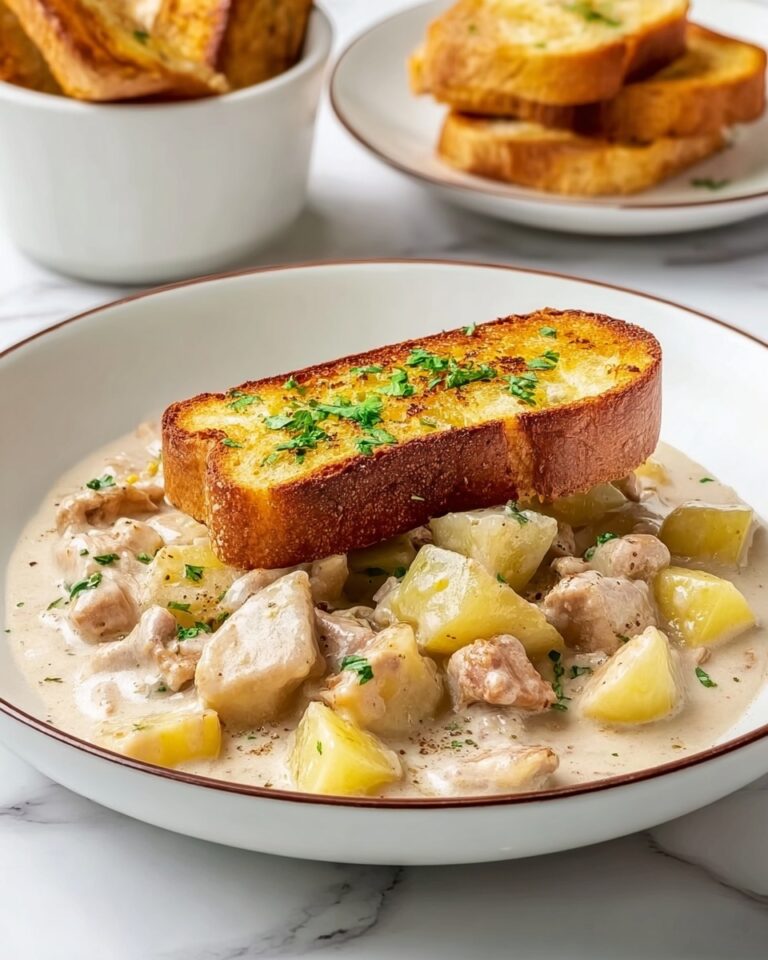If you’ve ever craved a Filipino noodle dish that bursts with vibrant flavors and colorful textures, then you’ll absolutely love this Pancit Palabok Recipe. This classic dish features delicate rice noodles drenched in a luscious, savory shrimp and pork sauce, sprinkled generously with crispy chicharrón, smoked fish flakes, and bright garnishes. It’s comfort food at its finest, combining the perfect balance of salty, tangy, and umami-packed elements that will transport your taste buds straight to a festive Filipino table. Whether you’re serving it for a family dinner or a special gathering, this Pancit Palabok Recipe is always a crowd-pleaser that’s as beautiful as it is delicious.
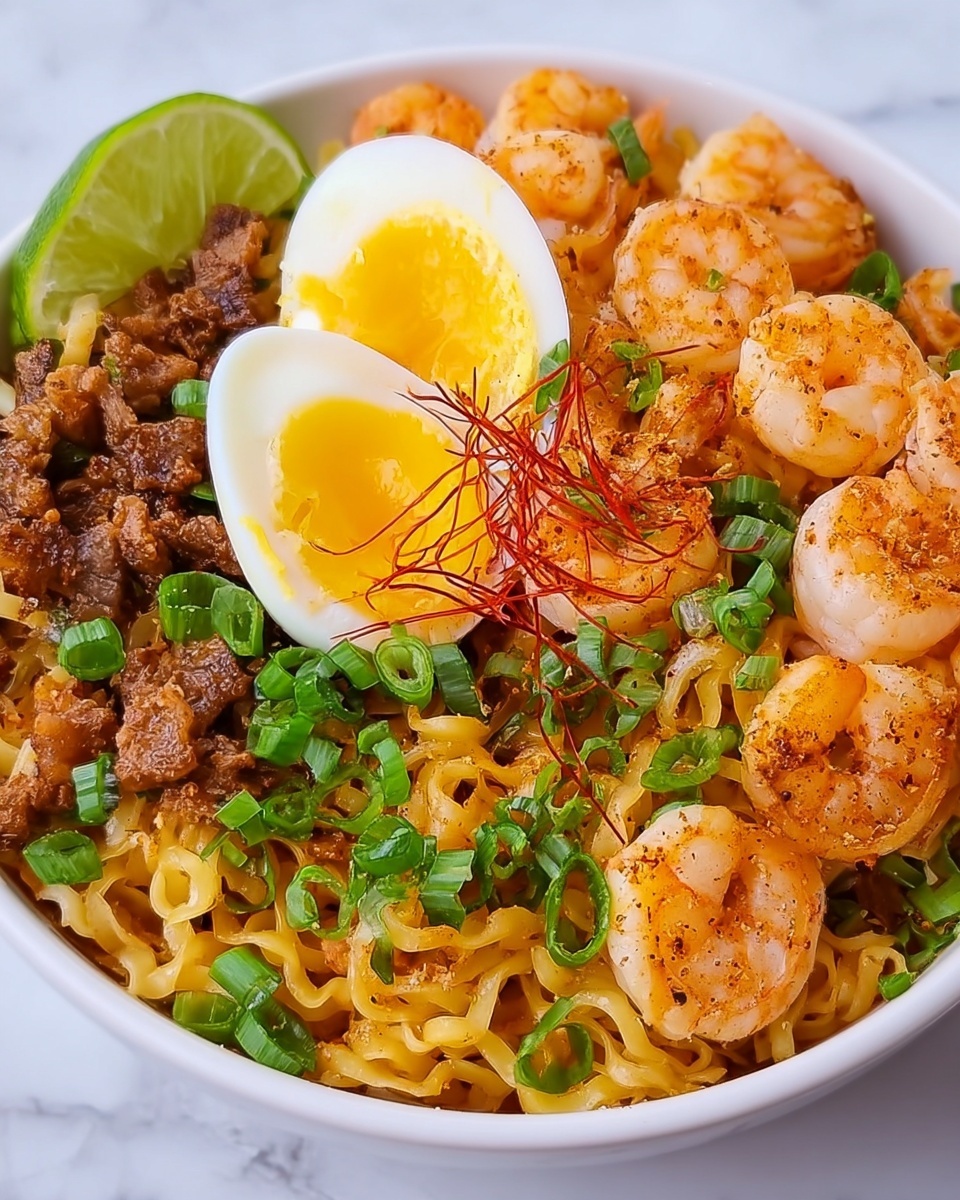
Ingredients You’ll Need
Every ingredient in this Pancit Palabok Recipe plays a crucial role, from lending vibrant color to adding rich texture. The beauty here is how simple, accessible ingredients come together to create a dish full of depth and tradition.
- 8 ounces rice noodles (bihon): These soft, thin noodles are the perfect canvas to soak up the flavors of the sauce.
- 2 tablespoons cooking oil: Used to sauté the aromatics and meat, infusing the dish with a savory base.
- 4 cloves garlic (minced): Essential for adding that irresistible fragrant punch.
- 1 small onion (chopped): Provides sweetness and a subtle bite to balance the richness.
- 1/2 pound ground pork: Adds hearty substance and meaty flavor.
- 1/2 cup shrimp (peeled and deveined): Brings a fresh, oceanic taste to the sauce.
- 1/2 teaspoon annatto powder: Responsible for the iconic orange hue and gentle earthiness of the sauce.
- 2 tablespoons fish sauce: This seasoning delivers an authentic salty and umami depth that can’t be replicated.
- 2 cups pork or shrimp broth: The flavorful liquid base that melds all ingredients together.
- 2 tablespoons cornstarch mixed with 2 tablespoons water: A simple slurry to thicken the luscious sauce perfectly.
- Salt and pepper to taste: To season and enhance every element of the dish.
- 1/2 cup crushed chicharrón (pork rinds): Adds unbeatable crunch and a salty pop of flavor.
- 2 hard-boiled eggs (sliced): A classic garnish that lends creamy richness and color contrast.
- 1/4 cup green onions (chopped): For a fresh, sharp bite and vibrant green color.
- 1/4 cup fried garlic: Intensifies the savory aroma and adds crispy texture.
- 1/4 cup smoked fish flakes (tinapa): These smoky flakes give a punchy character typical of traditional palabok.
- Calamansi or lemon wedges for serving: A squeeze of citrus brightens up every forkful.
How to Make Pancit Palabok Recipe
Step 1: Prepare the noodles
Start by soaking the rice noodles in warm water for about 10 to 15 minutes until they soften just enough to be manageable but still hold their shape. Once they’re ready, drain them well and set them aside. This step ensures your noodles will have the perfect tender texture after a quick blanch.
Step 2: Sauté aromatics and meat
Heat the cooking oil in a skillet over medium heat, then add the minced garlic and chopped onion. Sauté them until they release their irresistible fragrance and become slightly golden. Next, toss in the ground pork and cook until beautifully browned, adding a rich, meaty flavor foundation for the sauce.
Step 3: Cook the shrimp and flavor the base
Add the shrimp to the skillet and cook until they turn pink and plump, releasing their sweet ocean notes. Stir in the annatto powder and fish sauce; the annatto not only colors the sauce a stunning orange but brings a subtle earthiness, while the fish sauce introduces a salty, umami-packed complexity essential to this Pancit Palabok Recipe.
Step 4: Build and thicken the sauce
Pour the pork or shrimp broth into the skillet and bring the mixture to a gentle boil. Then lower the heat and stir in the cornstarch slurry. Keep stirring until the sauce thickens to a luscious consistency that will coat each noodle perfectly. Season with salt and pepper to taste, balancing all the flavors beautifully.
Step 5: Blanch the noodles
Bring a separate pot of water to a boil and blanch the soaked noodles for just 1 to 2 minutes until tender but not mushy. Drain the noodles well to avoid sogginess when assembled.
Step 6: Assemble the dish
Place the noodles on a large serving plate, then pour the thick sauce packed with pork and shrimp all over the top. This is where Pancit Palabok Recipe really shines—everything comes together in one glorious, flavorful mound.
How to Serve Pancit Palabok Recipe
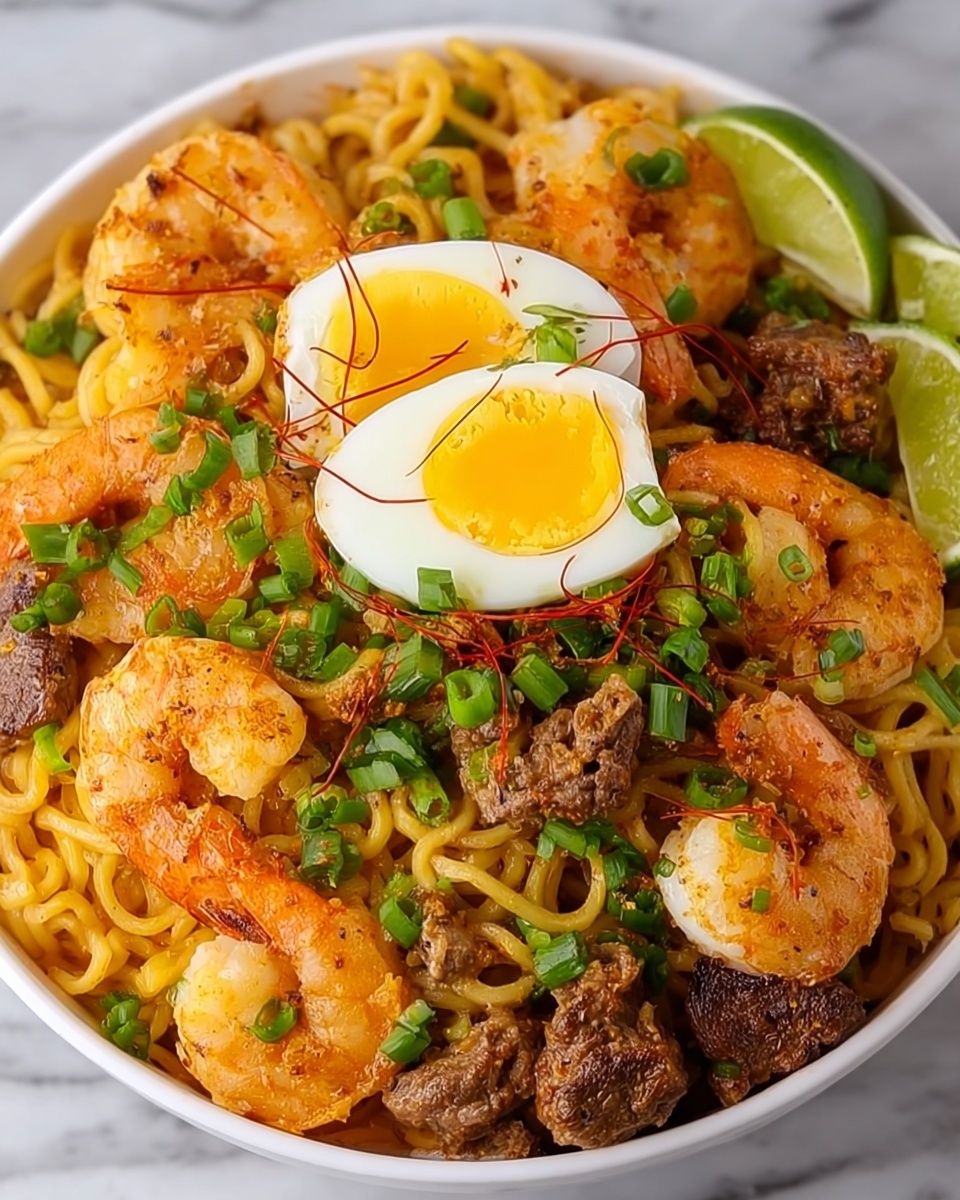
Garnishes
Garnishing isn’t just an afterthought for this dish; it’s a crucial layer of texture and flavor. Generously sprinkle crushed chicharrón for crunch, scatter hard-boiled egg slices for creaminess, add chopped green onions for sharpness, and finish with fried garlic and smoky tinapa flakes. These toppings not only make the dish look stunning but elevate every mouthful.
Side Dishes
Pancit Palabok is hearty on its own but pairs beautifully with simple Filipino sides like fresh lumpia, salted eggs, or a crisp fresh salad to cut through the richness. And don’t forget a few calamansi or lemon wedges on the side to brighten the experience!
Creative Ways to Present
If you want to impress dinner guests or make a festive feast feel extra special, serve Pancit Palabok in individual shallow bowls with the sauce and garnishes artistically arranged on top. Another fun twist is plating it family-style on a banana leaf to echo authentic Filipino celebrations.
Make Ahead and Storage
Storing Leftovers
Store any leftover Pancit Palabok in an airtight container and refrigerate for up to 2 days. The noodles will continue to absorb the sauce, which may change the texture slightly, but the flavors remain delicious.
Freezing
Freezing is generally not recommended for Pancit Palabok because the rice noodles tend to become mushy upon thawing. If you must freeze, separate the sauce from the noodles and freeze the sauce only; the noodles should be stored fresh and added when reheating.
Reheating
Reheat refrigerated Pancit Palabok gently in a skillet over medium-low heat. Add a splash of broth or water to loosen the sauce and prevent drying out. Stir frequently until warmed through, then add fresh garnishes if desired.
FAQs
Can I use other types of noodles for Pancit Palabok Recipe?
While traditional Pancit Palabok uses bihon rice noodles, you can experiment with other thin rice vermicelli if needed. Avoid thicker noodles as they won’t absorb the sauce as well.
Is there a vegetarian version of Pancit Palabok?
Yes! You can replace the pork and shrimp with mushrooms and tofu, use vegetable broth, and omit fish sauce or substitute with soy sauce. The key is to maintain that signature sauce flavor through creative seasoning.
Where can I find annatto powder?
Annatto powder is commonly found in Asian or Latin markets and adds both color and mild earthiness. If unavailable, you can use paprika for color, but the flavor won’t be quite the same.
What does tinapa flakes taste like?
Tinapa flakes are smoked fish flakes with a salty, smoky flavor that adds depth to the dish. If you can’t find them, smoked salmon flakes or smoked bacon bits can be a fun substitute.
Can Pancit Palabok Recipe be made gluten-free?
Absolutely! Just ensure your fish sauce and other condiments don’t contain gluten. Since the noodles are rice-based, this dish is naturally gluten-free in most cases.
Final Thoughts
If you want a dish that combines tradition, vibrant flavor, and a little bit of magic in every forkful, this Pancit Palabok Recipe is a must-try. It’s a comforting celebration of Filipino cuisine that’s perfect for sharing with loved ones. So grab your ingredients and start cooking—your happy, flavorful feast awaits!
Print
Pancit Palabok Recipe
- Prep Time: 15 minutes
- Cook Time: 20 minutes
- Total Time: 35 minutes
- Yield: 4 servings
- Category: Main Course
- Method: Stovetop
- Cuisine: Filipino
Description
Pancit Palabok is a classic Filipino noodle dish featuring rice noodles topped with a savory shrimp and pork sauce, garnished with crunchy chicharrón, sliced hard-boiled eggs, green onions, fried garlic, and smoky tinapa flakes. This vibrant and flavorful dish is perfect for family meals and celebrations, offering a delightful combination of textures and tastes.
Ingredients
Main Ingredients
- 8 ounces rice noodles (bihon)
- 2 tablespoons cooking oil
- 4 cloves garlic, minced
- 1 small onion, chopped
- 1/2 pound ground pork
- 1/2 cup shrimp, peeled and deveined
- 1/2 teaspoon annatto powder
- 2 tablespoons fish sauce
- 2 cups pork or shrimp broth
- 2 tablespoons cornstarch mixed with 2 tablespoons water (slurry)
- Salt and pepper to taste
Garnishes
- 1/2 cup crushed chicharrón (pork rinds)
- 2 hard-boiled eggs, sliced
- 1/4 cup green onions, chopped
- 1/4 cup fried garlic
- 1/4 cup smoked fish flakes (tinapa)
- Calamansi or lemon wedges for serving
Instructions
- Soften the noodles: Soak the rice noodles in warm water for 10 to 15 minutes until softened, then drain and set aside.
- Sauté aromatics: Heat cooking oil in a skillet over medium heat. Add the minced garlic and chopped onion, sautéing until fragrant and translucent.
- Cook pork and shrimp: Add ground pork to the skillet and cook until browned. Stir in shrimp and cook until the shrimp turns pink.
- Add seasoning and broth: Mix in the annatto powder and fish sauce, then pour in the pork or shrimp broth. Bring the mixture to a boil.
- Thicken the sauce: Reduce the heat to low, stir in the cornstarch slurry, and simmer until the sauce thickens to a smooth consistency. Season with salt and pepper to taste.
- Blanch noodles: In a separate pot, bring water to a boil and blanch the soaked noodles for 1 to 2 minutes until tender. Drain well.
- Assemble the dish: Arrange the noodles on a serving platter, pour the sauce with meat and shrimp evenly over the noodles.
- Garnish and serve: Top with crushed chicharrón, sliced hard-boiled eggs, chopped green onions, fried garlic, and tinapa flakes. Serve with calamansi or lemon wedges on the side for added zest.
Notes
- Annatto powder provides the signature orange color and a mild earthy flavor essential to the sauce.
- Tinapa flakes are smoked fish flakes commonly found in Filipino or Asian grocery stores and add a smoky depth to the dish; they can be substituted or omitted if unavailable.
- Use pork or shrimp broth for a richer flavor in the sauce.
- Adjust fish sauce and salt to taste depending on broth saltiness.
- Ensure noodles are not over-soaked or overcooked to maintain a firm yet tender texture.

